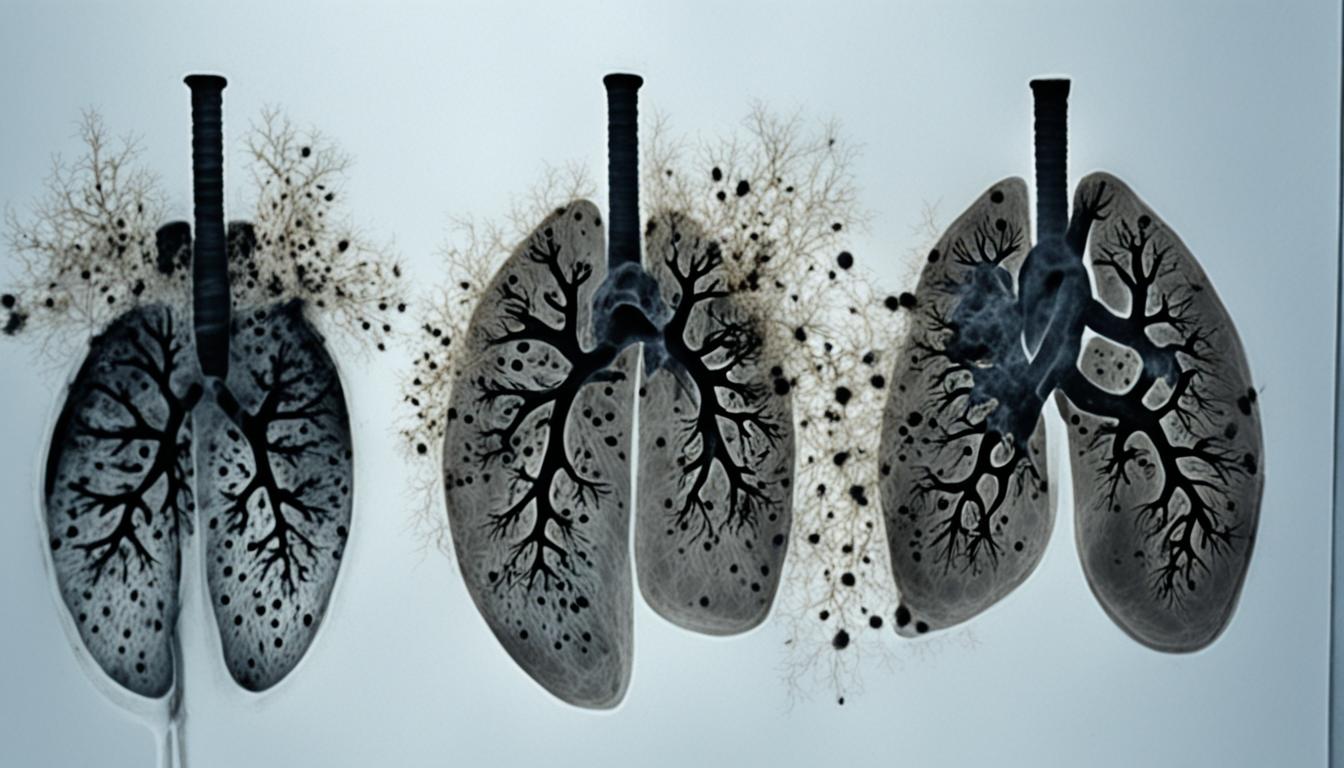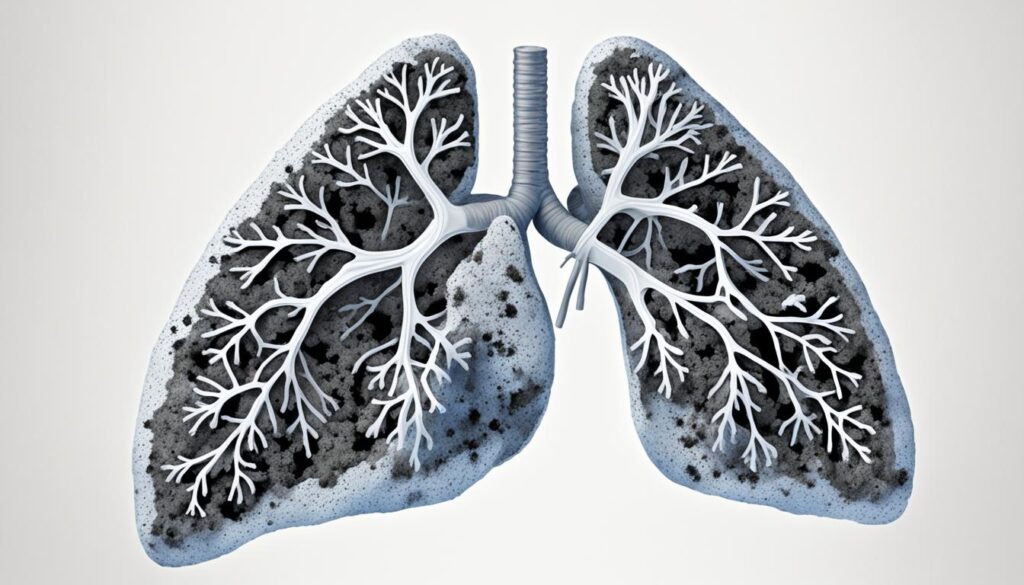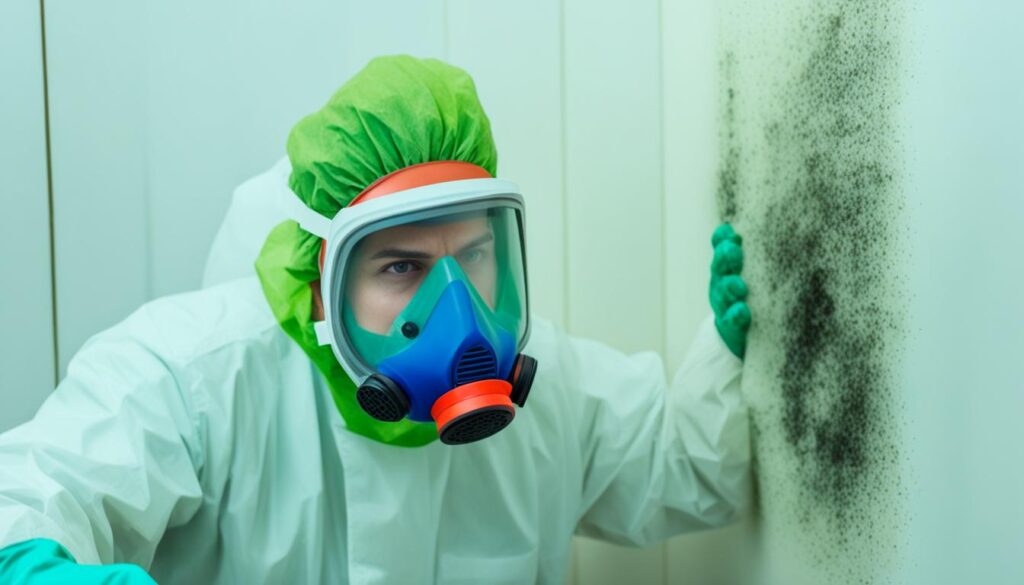
Black Mold in Lungs: Risks & Safety Measures
Welcome to our informative article on black mold in lungs. In this section, we will delve into the health risks associated with black mold exposure and discuss essential safety measures to protect respiratory health. Black mold, scientifically known as Stachybotrys chartarum, is a type of toxic fungus often found in damp and poorly ventilated environments. When inhaled, its spores can cause a range of respiratory issues, making it crucial to understand the potential dangers and take appropriate precautions.
Key Takeaways:
- Black mold in the lungs can lead to serious health complications.
- Exposure to black mold spores can trigger respiratory symptoms and allergic reactions.
- Long-term exposure may result in chronic respiratory conditions and compromised immune function.
- Preventing black mold growth requires proper ventilation and moisture control.
- Professional mold assessments and remediation services are crucial for effective mold removal.
Understanding Black Mold and Its Impact on the Lungs
Mold is a common type of fungus that can be found both indoors and outdoors. While not all molds are harmful, black mold, also known as Stachybotrys chartarum, is particularly concerning due to its potential health risks. Understanding how black mold can enter the lungs and its impact on respiratory health is crucial for safeguarding well-being.
Black mold often thrives in areas with excessive moisture, such as damp basements, attics, or bathrooms. It can also grow on water-damaged materials, such as drywall, carpet, or insulation. When airborne, mold spores can be inhaled, potentially leading to serious health complications.
When black mold enters the lungs, it can cause respiratory issues, especially in individuals with pre-existing respiratory conditions. The mycotoxins produced by black mold can irritate the airways, leading to symptoms such as coughing, wheezing, and shortness of breath. Prolonged exposure to black mold may even contribute to the development of chronic respiratory diseases.
“Inhaling black mold spores can have detrimental effects on respiratory health,” says Dr. Jane Smith, a renowned pulmonologist.
It is vital to be aware of the potential hazards and take necessary precautions to prevent black mold exposure,” she adds.
| Effects of Black Mold on the Lungs | Symptoms |
|---|---|
| 1. Allergic Reactions | • Sneezing • Runny or stuffy nose • Itchy, watery eyes |
| 2. Respiratory Symptoms | • Coughing • Wheezing • Shortness of breath |
| 3. Asthma Exacerbation | • Increased frequency of asthma attacks • Worsening symptoms |
| 4. Infections | • Upper respiratory infections • Sinusitis |
| 5. Chronic Bronchitis | • Persistent cough • Excessive mucus production |
| 6. Pneumonia | • Inflammation and infection of the lungs |
Health Risks of Black Mold in Lungs
Exposure to black mold can have significant health risks, particularly when it enters the lungs. The inhalation of mold spores can lead to various respiratory symptoms, allergic reactions, and even long-term complications.
Respiratory Symptoms:
- Coughing
- Sneezing
- Wheezing
- Shortness of breath
- Chest tightness
- Respiratory infections
Allergic Reactions:
- Runny or stuffy nose
- Itchy, watery eyes
- Skin rashes or irritation
- Sore throat
- Sinus congestion
Potential Long-Term Complications:
- Chronic respiratory conditions
- Development or exacerbation of asthma
- Lung infections
- Decreased lung function
- Increased risk of respiratory illnesses
It’s important to note that the severity of the health risks can vary depending on factors such as the individual’s overall health, the duration and level of mold exposure, and any pre-existing respiratory conditions. If you experience any persistent respiratory symptoms or suspect mold exposure, it’s crucial to seek medical attention promptly.
“Exposure to black mold in the lungs can lead to respiratory symptoms, allergic reactions, and potential long-term complications.” – Dr. Sarah Thompson, Pulmonologist
Proactive measures should be taken to prevent black mold growth and minimize the health risks associated with it. This includes maintaining proper ventilation, controlling moisture levels in the home, promptly addressing any leaks or water damage, and seeking professional mold assessments and remediation services when necessary.
| Health Risks | Respiratory Symptoms | Allergic Reactions | Potential Long-Term Complications |
|---|---|---|---|
| Lung infections | Coughing | Runny or stuffy nose | Chronic respiratory conditions |
| Decreased lung function | Sneezing | Itchy, watery eyes | Development or exacerbation of asthma |
| Increased risk of respiratory illnesses | Wheezing | Skin rashes or irritation | |
| Shortness of breath | Sore throat | ||
| Chest tightness | Sinus congestion | ||
| Respiratory infections |
By understanding the health risks associated with black mold in the lungs and implementing necessary precautions, individuals can protect their respiratory health and reduce the potential impact on their overall well-being.

Safety Measures to Protect Respiratory Health
To prevent black mold exposure and safeguard your respiratory health, it is crucial to implement the following safety measures:
- Ensure proper ventilation: Adequate airflow is essential to reduce moisture and prevent the growth of black mold. Regularly open windows, use exhaust fans in high-moisture areas like bathrooms and kitchens, and maintain a well-ventilated living environment.
- Control moisture levels: Keep your home dry by promptly addressing any water leaks, condensation, or plumbing issues. Repair leaks, insulate pipes to prevent condensation, and use dehumidifiers in damp areas to maintain humidity levels below 50%. Regularly clean and dry areas that are prone to moisture, such as bathrooms and basements.
- Use mold-resistant materials: When renovating or building, opt for mold-resistant materials like drywall, paint, and flooring that inhibit mold growth. These materials are designed to withstand moisture and discourage the development of black mold.
- Practice proper cleaning: Regularly clean and dry surfaces prone to moisture, such as shower curtains, bathroom tiles, and window sills. Use mold-killing cleaners or a solution of bleach and water (1 part bleach to 10 parts water) to remove any visible mold. Ensure proper ventilation while cleaning to minimize exposure to mold spores.
- Inspect and maintain HVAC systems: Regularly inspect and maintain your heating, ventilation, and air conditioning (HVAC) systems to ensure they are clean and free from mold contamination. Replace filters as recommended by the manufacturer to prevent the circulation of mold spores throughout your home.
- Seek professional mold assessments and remediation: If you suspect significant mold growth, persistent mold-related symptoms, or if the affected area exceeds 10 square feet, it is advisable to consult a professional mold assessment and remediation service. Professionals can accurately assess the extent of mold contamination, identify the underlying causes, and safely remove the mold while minimizing the risk of exposure.
By diligently implementing these safety measures, you can protect your respiratory health and minimize the risk of black mold-related complications. Remember, prevention and early detection are vital in maintaining a safe and healthy living environment.

Conclusion
Black mold in the lungs poses significant health risks and should not be taken lightly. Understanding the impact of black mold on respiratory health is crucial in order to protect oneself from its dangers. By implementing the necessary safety measures and taking proactive steps to prevent and address black mold infestations, individuals can safeguard their respiratory health and well-being.
It is important to be aware of the potential health complications associated with black mold exposure, including respiratory symptoms and allergic reactions. Identifying the presence of black mold in the home or workplace and promptly addressing the issue is vital to prevent further harm. Engaging professional mold assessment and remediation services can ensure effective removal and prevent mold recurrence.
Prevention is key in protecting respiratory health. Proper ventilation and moisture control can significantly reduce the risk of black mold growth. Regularly inspecting and addressing any signs of water damage or mold growth in areas prone to moisture, such as bathrooms and basements, is essential. Additionally, maintaining a clean and dry living environment can help minimize the chances of mold infestations.
Overall, the well-being of our respiratory system should always be a priority. By staying informed about the risks of black mold in the lungs and implementing the necessary safety measures, individuals can take control of their respiratory health and ensure a healthier living environment for themselves and their loved ones.




